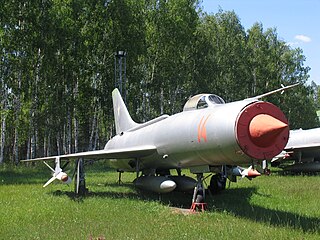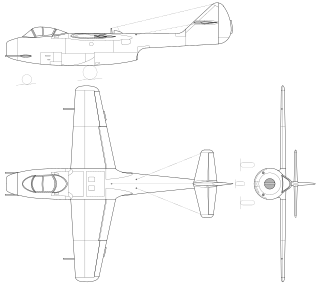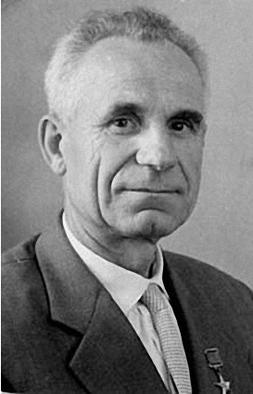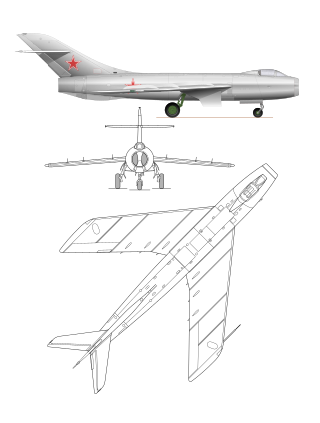
The Sukhoi Su-11 is an interceptor aircraft used by the Soviet Union during the Cold War.

The Lyulka AL-21 is an axial flow turbojet engine created by the Soviet Design Bureau named for its chief designer Arkhip Lyulka.

The Sukhoi Su-9 was an early jet fighter built in the Soviet Union shortly after World War II. The design began in 1944 and was intended to use Soviet-designed turbojet engines. The design was heavily influenced by captured German jet fighters and it was subsequently redesigned to use a Soviet copy of a German turbojet. The Su-9 was slower than competing Soviet aircraft and it was cancelled as a result. A modified version with different engines and a revised wing became the Su-11, but this did not enter production either. The Su-13 was a proposal to re-engine the aircraft with Soviet copies of the Rolls-Royce Derwent turbojet as well as to modify it for night fighting, but neither proposal was accepted.

The Yakovlev Yak-19 was a prototype Soviet fighter built in the late 1940s. It was the first Soviet aircraft to be equipped with an afterburning turbojet, the Klimov RD-10F that was derived from the German Jumo 004 engine. Only two examples were built as it was rejected for service by the Soviet Air Force.

The Ilyushin Il-30 was a Soviet turbojet-powered tactical bomber designed as a higher-performance, swept wing version of the Ilyushin Il-28, in the late 1940s. Its thin wing and engine nacelles necessitated the use of tandem landing gear, the first Soviet aircraft to do so. It was apparently canceled before the prototype made its first flight, although sources disagree with this.

The Lyulka AL-7 was a turbojet designed by Arkhip Mikhailovich Lyulka and produced by his Lyulka design bureau. The engine was produced between 1954 and 1970.

The Lavochkin La-150, was designed by the Lavochkin design bureau (OKB) in response to a 1945 order to build a single-seat jet fighter using a single German turbojet. By this time both the Americans and British, as well as the Germans, had already flown jet fighters and the single Soviet jet engine under development was not yet ready for production. The design was completed quickly, but the construction of the five flying prototypes was protracted by the factory's inexperience in building metal aircraft. The aircraft made its first flight in September 1946, but proved to require extensive modifications to meet the Soviet Air Forces' requirements. These took so long to make and test that the aircraft was essentially obsolete by the time that they were completed. Even one variant with a much more powerful engine was inferior to other aircraft that the OKB had under development and all work was terminated in 1947.

The Saturn AL-31 is a family of axial flow turbofan engines, developed by the Lyulka-Saturn design bureau in the Soviet Union, now NPO Saturn in Russia, originally as a 12.5-tonne powerplant for the Sukhoi Su-27 long range air superiority fighter. The AL-31 currently powers the Su-27 family of combat aircraft and some variants of the Chengdu J-10 multirole jet fighter. Assembly of the engine is also performed under license in India by HAL, for the Sukhoi Su-30MKI. Improved variants power the fifth-generation Sukhoi Su-57 and Chengdu J-20.
The Sukhoi Su-10 or Izdeliye Ye was a Soviet turbojet-powered bomber aircraft built shortly after World War II.

Arkhyp Mykhailovych Lyulka was a Soviet scientist and designer of jet engines, head of the OKB Lyulka, member of the Academy of Sciences of the Soviet Union.

The Sukhoi Su-17 was a prototype Soviet fighter. The name was later reused for an entirely different fighter-bomber, see Sukhoi Su-17.

The Ilyushin Il-22, USAF/DOD designation Type 10, was the first Soviet jet-engined bomber to fly. It used four Lyulka TR-1 turbojets carried on short horizontal pylons ahead and below the wing. The engines did not meet their designed thrust ratings and their fuel consumption was higher than planned. These problems meant that the aircraft could not reach its required performance and it was cancelled on 22 September 1947.

The Lavochkin La-152,, and its variants, was a jet fighter prototype designed and manufactured by the Lavochkin Design Bureau (OKB) shortly after the end of World War II. Derived from the Lavochkin La-150, the 152 used several different engines, but the program was canceled as other fighters with more powerful engines and swept wings showed more promise.

The Alekseyev I-21 was a Soviet twin-engined jet fighter, built in the late 1940s. Two prototypes were constructed with the designation of I-211, of which one was converted into the I-215 with more powerful engines. A third aircraft was built to evaluate the bicycle landing gear arrangement for use in other aircraft. The fighter was not accepted for production as it was inferior to the swept-wing fighters like the Mikoyan-Gurevich MiG-15.
The Lyulka AL-5 was a Soviet axial compressor turbojet developed from the Lyulka TR-3 turbojet around 1950. It was flight-tested in a number of prototype aircraft, but was not accepted for production.
The Lyulka TR-3 was a Soviet axial turbojet designed after World War II by Arkhip Mikhailovich Lyulka.

The Yakovlev Yak-1000 was a Soviet supersonic technology demonstrator intended to evaluate the aerodynamic layout and field performance of the cropped delta wing discussed in captured German documents in combination with the new Lyulka AL-5 turbojet. The tandem undercarriage proved to be unsatisfactory and there were serious flight stability problems related to the delta wing, enough so that it never flew after an accident during taxiing tests.
The Mikoyan-Gurevich I-75 was the final design of a series of three experimental swept-wing interceptors developed in the Soviet Union in the mid-late 1950s by the Mikoyan-Gurevich design bureau from their Mikoyan-Gurevich I-3 airframe. All the aircraft in the I-3 program were affected by delays in the development of the Klimov VK-3 turbojet engine, its cancellation and ultimate replacement by the Lyulka AL-7F turbojet engine.

The Tumansky R-29 is a Soviet turbojet aircraft engine that was developed in the early 1970s. It is generally described as being in the "third generation" of Soviet gas turbine engines which are characterized by high thrust-to-weight ratios and the use of turbine air cooling.
The Mikoyan-Gurevich I-350, was a Soviet Cold War-era experimental fighter aircraft. It was the first Soviet aircraft able to maintain supersonic speed.